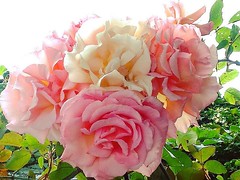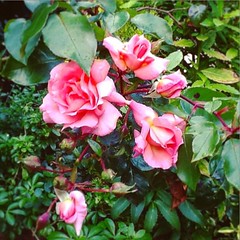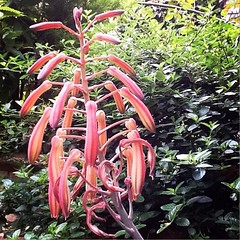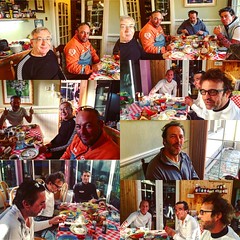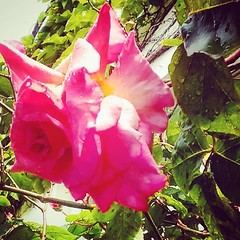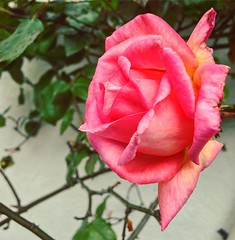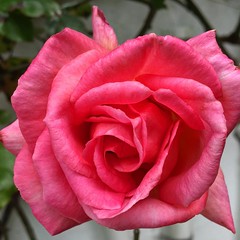Archive for the ‘bed and breakfast’ Category
December 26, 2013
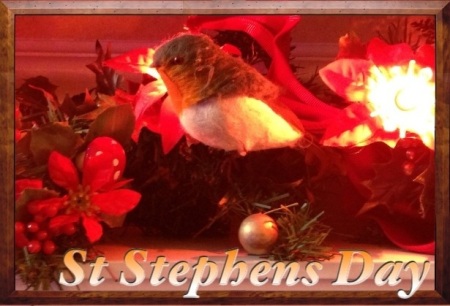
Brookville House Dublin Ireland wishes you and yours a Very Happy St. Stephen’s Day (Lá Fhéile Stiofáin), also known here as The Day of the Wren (Lá an Dreoilín), it is an occasion to commemorate the life of St Stephen, a Christian martyr. To our friends in the United Kingdom we wish you and yours a Happy Boxing Day. Today is a big day for racing especially at Leopardstown Racecourse (less than 2km from Brookville House) and hunting in Ireland and traditionally the post Christmas sales start in the shops. In some parts of Ireland, children go from door to door with a wren (a small bird) in a cage or a model wren on a stick as legend links episodes in the life of Jesus to the wren. They sing, play music or perform traditional dances. In some areas, boys may dress as girls or women. Many hope to collect money for community or school projects or charity. Depending on which region of the country, they are called wrenboys and mummers. A Mummer’s Festival is held at this time every year in the village of New Inn, County Galway and Dingle in County Kerry. Actually, the famous Irish writer John B. Keane based his novel ‘The Bodhran Maker’ on the activities of the Wren Boys in his native County Kerry.
Locally The Wrens Boy Festival takes place each year in Sandymount. This year The Wren Boys celebration at Sandymount Green, Dublin 4 commences at 11.00am with poetry readings in Gus Ryans Pub. The music and dancing kicks off at 12am on the Gig Rig, with the Swords Mummers, the Ned O’Shea Musicians/Dancers, the Shamrockers and many others from far and wide playing bodhrans, bagpipes, tin whistles and even combs along with musicians across all cultures to add variety and excitement to the day. Proceeds go to charity.
St. Stephen’s Day is also a popular day in Ireland for visiting family members. A popular rhyme, known to many Irish children and sung at each house visited by the wrenboys goes as follows (this version popularized by the Irish group The Clancy Brothers):
The wren, the wren, the king of all birds,
St. Stephen’s Day was caught in the furze,
Although he was little his honour was great,
Jump up me lads and give us a treat.
As I was going to Killenaule,
I met a wren upon the wall.
Up with me wattle and knocked him down,
And brought him in to Carrick Town.
Drooolin, Droolin, where’s your nest?
Tis in the bush that I love best
In the tree, the holly tree,
Where all the boys do follow me.
Up with the kettle and down with the pan,
And give us a penny to bury the wren.
I followed the wren three miles or more,
Three miles or more three miles or more.
I followed the wren three miles or more,
At six o’clock in the morning.
I have a little box under me arm,
Under me arm under me arm.
I have a little box under me arm,
A penny or tuppence would do it no harm.
Mrs. Clancy’s a very good woman,
a very good woman, a very good woman,
Mrs. Clancy’s a very good woman,
She give us a penny to bury the wren.
A variant sung in the County Cork had a different explanation why the wren was the King of birds:
The wren, the wren, the King of All Birds,
On Saint Stephen’s Day he was caught in the furze.
Although he is small his family is great.
Come out, good lady, and give us a treat.
St Stephen is believed to be the first Christian martyr. He was stoned to death sometime around the year 33 CE. According to an Irish legend, he was betrayed by a wren while hiding from his enemies. Another legend tells of Viking raids on Ireland on St Stephen’s Day sometime around the year 750 CE. Irish soldiers were approaching a Viking camp to drive out the intruders. However, a wren started eating crumbs from a drum and alerted the Vikings to the presence of the Irish soldiers.
Hence, some people felt that wrens betrayed them and should be stoned to death, just as St Stephen was. Boys traditionally hunted a wren and threw stones at it. They tied it to a stick when it was dead and paraded it around the village. They did this to collect money for a dance or party for the whole village. Although the custom of killing wrens on December 26 died out around 1900, St Stephen’s Day is still known as the Day of the Wren, particularly in rural areas.
St Stephen’s Day has been a holiday in Ireland for hundreds of years. It became a public holiday following the Bank Holidays Act 1871.

0.000000
0.000000
Tags:accommodation, Boxing Day, Brookville House, custom, dance, Dingle, Dublin, festival, folklore, horse, hunt, Ireland, Irish, Kerry, legend, Leopardstown, music, racing, sales, Sandymount, st Stephens Day, tradition, wren
Posted in accommodation, bed and breakfast, birds, boxing day, Brookville House Dublin, Christmas, customs, December, Dublin, fans, feast day, festival, festive, gaeilge, guest, guest house, Happy Christmas, heritage, holiday, holly, hospitality, hotel, hunt, Ireland, irish, irish blessing, Merry Christmas, mummers, saint, Seasons greetings, st stephens Day, Tours, tradition, travel, twitter, wren | Leave a Comment »
December 24, 2013
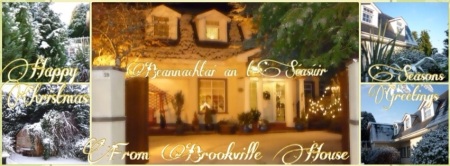
Nollaig Shona daoibh go leir! Happy Christmas! Joyeux Noël, Frohe Weihnachten, Buon Natale, Feliz Navidad, Wesołych Świąt, Geseënde Kersfees, Gëzuar Krishtlindjet, عيد ميلاد سعيد, Шчаслівага Раства, Честита Коледа, Bon Nadal, 圣诞快乐, 聖誕快樂, Sretan Božić, Veselé Vánoce, Glædelig jul, Hyvää joulua, Bo Nadal, Καλά Χριστούγεννα, Nwèl kè kontan, חג מולד שמח, हैप्पी क्रिसमस, Boldog Karácsonyt, Selamat Natal, ハッピークリスマス, 메리 크리스마스, Честит Божиќ, Selamat Natal, Milied it-Tajjeb, God Jul.
Happy Christmas to our guests, family, friends, fans, followers, to all who we welcomed here for the first time this year and to those who stayed with us over the years- you arrived as guests and left as friends with a special place in our hearts, we thank you for wonderful times shared, laughter and special memories, for sharing your lives, countries and cultures with us, we hope you enjoyed your time here in your Irish home from home, thank you for your support, we look forward to welcoming you back in 2014, we wish you all the very best of everything this Christmas, have a wonderful festive season,
All our love, thanks and warmest wishes always, Enjoy and look after each other, Mile buiochas agus dea ghui,
Nollaig shona dhaoibh go leir,
Liam and Dei, Brookville House
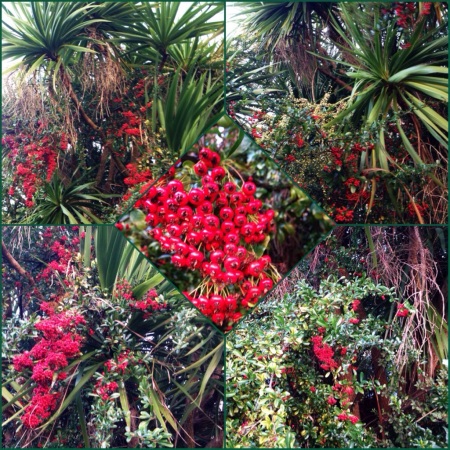
Winter berries in the grounds of Brookville House December 2013.
53.286052
-6.168168
Tags:Aviva stadium, b&b, bed and breakfast, Blackrock, Blackrock Clinic, Brookville Guest House, Brookville House Dublin, car parking, Christmas, concert accommodation, corporate accommodation, Dublin, Dublin airport, Dublin Port, Dun Laoghaire, family accommodation, Foxrock, free wifi, greetings, guest, guest house, holiday, home, hostel, hotel, hydrotherapy, Ireland, Irish, Irish breakfast, Monkstown, pet friendly, RDS, rugby accommodation, sauna, Seasons Greetings, spa, staycation, Stillorgan, student accommodation, tourism, tradition, travel, UCD accommodation, vacation
Posted in 2013, bed and breakfast, berry, Brookville House Dublin, Christmas, Christmas tree, customs, December, Dublin, fans, feast day, festival, festive, gaeilge, guest, guest house, Happy Christmas, heritage, holiday, holly, hospitality, hotel, Ireland, irish, irish blessing, Merry Christmas, Seasons greetings, snow, Tours, tradition, travel, Uncategorized, Vacations, winter | Leave a Comment »
February 25, 2013
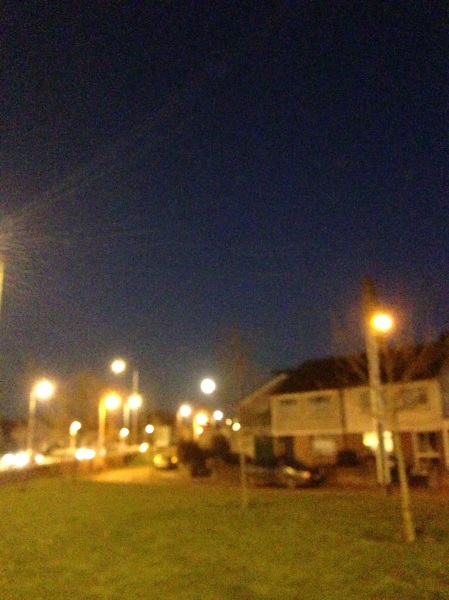
Snow moon on Monkstown Ring Road Dublin tonight, much brighter than the street lights under it
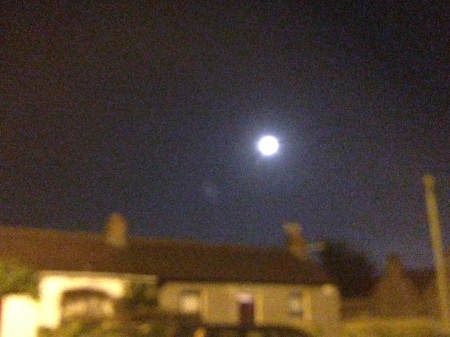
Tonights full moon over cottages on Deansgrange Rd opposite cemetary, amazing sight!
And here it is when we zoom the camera in:

Tonight’s full moon 25/02/2013 is an amazing sight in the Irish night Sky, a dramatic sight inspiring and captivating all. The February Full Moon is known as The Snow Moon (as the heaviest snows fall at this time in N America) or Storm Moon or Hunger Moon (as hunting was difficult and food scarce in this month for ancient tribes). It is a beautifully bright big round moon or as they say in these parts: Ta gealach ghalanta ann anocht! Enjoy everyone, oiche maith agus codladh samh, night night and sleep well from Brookville House Dublin Ireland.
Tags:accommodation, bed, bed and breakfast, Blackrock, bright, Brookville House, Deansgrange, Dublin, Full moon, Gaelach, guest, guest house, holiday, home, hospitality, hotel, Hunger Moon, hunting, Ireland, Irish, light, Monkstown, night sky, Oiche, planet, road, sightseeing, Snow, Snow Moon, star, Storm Moon, street, tour, travel
Posted in 2013, About, accommodation, astronomy, bed and breakfast, Brookville House Dublin, customs, Dublin, February, full moon, gaeilge, gaelic, gealach, guest, guest house, Happy Christmas, heritage, holiday, hospitality, hotel, hunt, Ireland, irish, irish blessing, night sky, planets, Sightseeing, snow, space, spring, The Gathering, Tours, tradition, travel, Uncategorized, Vacations | Leave a Comment »
February 1, 2013
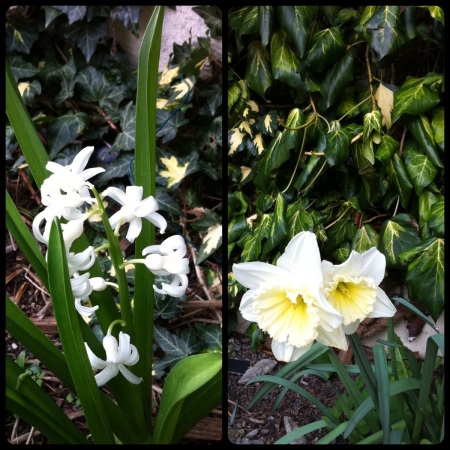
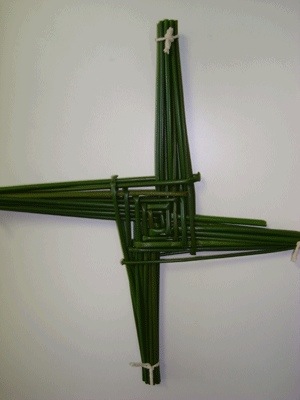
Top photo is one of Spring Blossoms in the gardens of Brookville House Dublin Ireland taken by Liam and Dei (proprietors), the second photo is a photo showing a St Brigid’s Cross, a traditional cross made from rushes to celebrate St Brigid’s Day in Ireland.
Brookville House sends all a St Brigid's Blessing from our home to yours, we look forward to welcoming all who will stay with us this year for The Gathering 2013:
May Brigid bless the house where you dwell,
every fireside door and every wall;
every heart that beats beneath its roof,
every hand that toils to bring it joy,
every foot that walks its portals through.
may Brigid bless the house that shelters you.
Spring begins officially on St Brigid’s Day, the first day of February, which is also the feast of Imbolc, the ancient pagan spring festival and the first day of the Celtic agricultural year. In Irish mythology the father of all the Irish gods was Dagda. He had a daughter, Brigit, designated the mother goddess, the exalted one and goddess of fertility. Her symbol was fire. The fiery dart of Brigit is represented by a sun symbol which, in later times, developed into what we now call St Brigid’s cross.
St. Brigid’s Cross
January 31st, the eve of St. Brigid’s Day, was once known as “Oidhe na Cruha” the night of the crosses. Her memory is honored by people who weave crosses from rushes or straw. A St. Brigid’s Cross made from new straw is hung above the door, and the old one is burned in the hearth. Just as the shamrock is associated with St. Patrick, so is the tiny cross made of rushes linked to St. Brigid. While explaining the Passion to a dying pagan, she wove a cross from the rushes thrown about the floor. The man was baptized before he died.These “Saint Brigid” crosses are believed to bestow the Saint’s special blessings on your households.
How to Make St Brigid’s Cross
Just as the shamrock is associated with St Patrick, a cross made from rushes is the symbol of St Brigid. This is one of the most widespread Irish customs associated with her.
Legend tells how she picked up rushes from the floor and began to weave them into a cross while she sat at the deathbed of a pagan chieftain. When he asked what she was doing, she told him about Jesus and his death on the cross. Before he died, the chieftain asked to be baptised.
Crosses are traditionally made from rushes, but they can also be made from wheat stalks, grasses, or reeds. If the reeds or rushes are dry and brittle, soak them to soften them. The crosses are typically made on the eve of St Brigid’s Day and placed above the door of the house for blessing and protection.
Directions:
1. Hold one reed vertically, and fold another in half around the mid-point of the first.
2. Take a third reed and fold it around the second one, parallel to the first. You should now have a T-shaped piece, with one arm having one strand, another having two and the third having three.
3. Fold a fourth reed around the third one to form a cross.
4. Fold a fifth one around the fourth, parallel to the single strand. As you work, snug the reeds against the centre and hold it tight.
5. Continue folding reeds around the previous one (and the ones beside it) working in a circular fashion until you have created enough of a woven centre.
6. When the centre is as big as you like, hold the reeds together carefully and tie the ends of each arm tightly with reeds, string or some type of natural fibre. Trim the ends with scissors.
A traditional blessing said in some parts of Ireland for the hanging of St Brigid’s cross:
“May the blessing of God and the Trinity be on this cross,
and on the home where it hangs and on everyone who looks at it.”
St. Brigid’s Mantle
In very traditional homes, two devout practices are still observed on the Eve of St. Brigid’s Feast Day (February 1st). A strip of cloth called “brat Bhride” (Brigid’s mantle) is hung outside the door. A loaf of oat bread baked in the shape of a cross and a sheaf of straw are left on the windowsill. For on that night, Brigid travels through the land with her red-eared cow bestowing blessings on those who keep the old ways.
In early Christian times Imbolc was taken over and pagan Brigit was transformed into a saint (with a Christian mythology to equal her pagan one). Saint Brigid became Ireland’s second patron saint, the patroness of sheep, cattle, dairy work, poets (and much more). Since there are few facts known about the Christian Brigid, there remained a tension between Brigit and the miraculous deeds of St Brigid because so many pagan elements influenced the ‘traditional’ lore of St Brigid.
The main significance of the feast of St Brigid was that it Christianised one of the pagan focal points of the agricultural year – when preparations for spring sowing were begun and spring lambing started – so St Brigid was given special responsibility for the protection of farm animals and crops. In rural Ireland this feast was a day of stocktaking in household and farmyard: the housewife counted how much meal, bacon, potatoes and other foods she had in store; the farmer considered how long his stock of hay and other winter fodder would last until the grass began to grow again.
St Brigid is the Patron Saint of Many,
St. Brigid is the Patroness of:
Ireland:
The people of Ireland, since the sixth century, have declared St. Brigid their’s, second only to St Patrick.She was formally named a Patroness of Ireland in 1962.
Ladies Ancient Order of Hibernians:
It is St. Brigid that we emulate when we pursue our motto, “Friendship, Unity, and Christian Charity.”
Dairy Workers:
Once a leprous woman asking for milk, there being none at hand, St. Brigid gave her cold water, but the water was turned into milk, and when she had drunk it the woman was healed.
Beer and Brewers:
Like her mentor St. Patrick, she was fond of ale and is reputed to have been the best brewer in the land. Thus, she supplied beer out of one barrel to eighteen churches, which sufficed from Maundy Thursday to the end of the Paschal time.
She is also the Patron Saint of poets, students, blacksmiths, healers, cattle, dairymaids, midwives, fugitives, and children born out of wedlock.
Knights of Chivalry, Legend of the Bride
One of the most prettiest legends concerning Saint Brigid tells us that as St. Bride she was the patroness of the Knights of Chivalry. They began the custom of calling the girls they married their brides; and that from the Knights of Chivalry the word bride came into general usage in the English language.
St Brigids Well, Kildare, Photo by Mario Corrigan

Photo of Cherry Blossom Brookville House Dublin taken by Liam and Dei (proprietors)
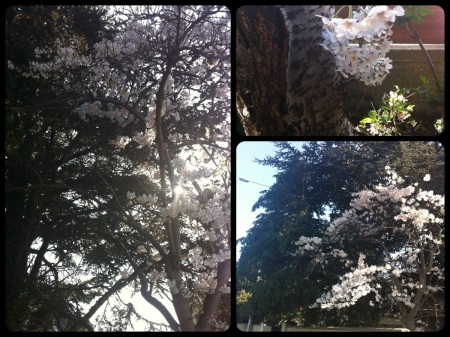
Tags:1st February, agriculture, beer, blessing, blossom, brewers, Bride, Bridget, Brigit, Brookville House, Christian, Cross, culture, custom, Dagda, dairy, dairymaids, Dublin, farmer, feast, festival, Hibernian, home, Imbolc, Ireland, Irish, Kildare, Knights of Chivalry, mantle, midwives, pagan, patron, patroness, poets, reed, rushes, Spring, St Brigid, students, The Gathering, tradition, Well
Posted in 2013, accommodation, bed and breakfast, bridget, Brookville House Dublin, customs, Dublin, fans, feast day, February, festival, guest, guest house, heritage, holiday, hospitality, hotel, imbolc, Ireland, irish, irish blessing, saint, Sightseeing, spring, St Brigid, The Gathering, Tours, tradition, travel, Uncategorized, Vacations | Leave a Comment »
February 1, 2013

Spring Blossoms in Gardens of Brookville House Dublin Ireland, photo by Liam and Dei (proprietors)
<img src="https://brookvilleguesthousedublin.files.wordpress.com/2013/02/20130201-180752.jpg"
A photo of St Brigid's Cross
Brookville House sends all a St Brigid's Blessing from our home to yours, we look forward to welcoming all who will stay with us this year for The Gathering 2013:
May Brigid bless the house where you dwell,
every fireside door and every wall;
every heart that beats beneath its roof,
every hand that toils to bring it joy,
every foot that walks its portals through.
may Brigid bless the house that shelters you.
Spring begins officially on St Brigid’s Day, the first day of February, which is also the feast of Imbolc, the ancient pagan spring festival and the first day of the Celtic agricultural year. In Irish mythology the father of all the Irish gods was Dagda. He had a daughter, Brigit, designated the mother goddess, the exalted one and goddess of fertility. Her symbol was fire. The fiery dart of Brigit is represented by a sun symbol which, in later times, developed into what we now call St Brigid’s cross.
St. Brigid’s Cross
January 31st, the eve of St. Brigid’s Day, was once known as “Oidhe na Cruha” the night of the crosses. Her memory is honored by people who weave crosses from rushes or straw. A St. Brigid’s Cross made from new straw is hung above the door, and the old one is burned in the hearth. Just as the shamrock is associated with St. Patrick, so is the tiny cross made of rushes linked to St. Brigid. While explaining the Passion to a dying pagan, she wove a cross from the rushes thrown about the floor. The man was baptized before he died.These “Saint Brigid” crosses are believed to bestow the Saint’s special blessings on your households.
How to Make St Brigid’s Cross
Just as the shamrock is associated with St Patrick, a cross made from rushes is the symbol of St Brigid. This is one of the most widespread Irish customs associated with her.
Legend tells how she picked up rushes from the floor and began to weave them into a cross while she sat at the deathbed of a pagan chieftain. When he asked what she was doing, she told him about Jesus and his death on the cross. Before he died, the chieftain asked to be baptised.
Crosses are traditionally made from rushes, but they can also be made from wheat stalks, grasses, or reeds. If the reeds or rushes are dry and brittle, soak them to soften them. The crosses are typically made on the eve of St Brigid’s Day and placed above the door of the house for blessing and protection.
Directions:
1. Hold one reed vertically, and fold another in half around the mid-point of the first.
2. Take a third reed and fold it around the second one, parallel to the first. You should now have a T-shaped piece, with one arm having one strand, another having two and the third having three.
3. Fold a fourth reed around the third one to form a cross.
4. Fold a fifth one around the fourth, parallel to the single strand. As you work, snug the reeds against the centre and hold it tight.
5. Continue folding reeds around the previous one (and the ones beside it) working in a circular fashion until you have created enough of a woven centre.
6. When the centre is as big as you like, hold the reeds together carefully and tie the ends of each arm tightly with reeds, string or some type of natural fibre. Trim the ends with scissors.
A traditional blessing said in some parts of Ireland for the hanging of St Brigid’s cross:
“May the blessing of God and the Trinity be on this cross,
and on the home where it hangs and on everyone who looks at it.”
St. Brigid’s Mantle
In very traditional homes, two devout practices are still observed on the Eve of St. Brigid’s Feast Day (February 1st). A strip of cloth called “brat Bhride” (Brigid’s mantle) is hung outside the door. A loaf of oat bread baked in the shape of a cross and a sheaf of straw are left on the windowsill. For on that night, Brigid travels through the land with her red-eared cow bestowing blessings on those who keep the old ways.
In early Christian times Imbolc was taken over and pagan Brigit was transformed into a saint (with a Christian mythology to equal her pagan one). Saint Brigid became Ireland’s second patron saint, the patroness of sheep, cattle, dairy work, poets (and much more). Since there are few facts known about the Christian Brigid, there remained a tension between Brigit and the miraculous deeds of St Brigid because so many pagan elements influenced the ‘traditional’ lore of St Brigid.
The main significance of the feast of St Brigid was that it Christianised one of the pagan focal points of the agricultural year – when preparations for spring sowing were begun and spring lambing started – so St Brigid was given special responsibility for the protection of farm animals and crops. In rural Ireland this feast was a day of stocktaking in household and farmyard: the housewife counted how much meal, bacon, potatoes and other foods she had in store; the farmer considered how long his stock of hay and other winter fodder would last until the grass began to grow again.
St Brigid is the Patron Saint of Many,
St. Brigid is the Patroness of:
Ireland:
The people of Ireland, since the sixth century, have declared St. Brigid their’s, second only to St Patrick.She was formally named a Patroness of Ireland in 1962.
Ladies Ancient Order of Hibernians:
It is St. Brigid that we emulate when we pursue our motto, “Friendship, Unity, and Christian Charity.”
Dairy Workers:
Once a leprous woman asking for milk, there being none at hand, St. Brigid gave her cold water, but the water was turned into milk, and when she had drunk it the woman was healed.
Beer and Brewers:
Like her mentor St. Patrick, she was fond of ale and is reputed to have been the best brewer in the land. Thus, she supplied beer out of one barrel to eighteen churches, which sufficed from Maundy Thursday to the end of the Paschal time.
She is also the Patron Saint of poets, students, blacksmiths, healers, cattle, dairymaids, midwives, fugitives, and children born out of wedlock.
Knights of Chivalry, Legend of the Bride
One of the most prettiest legends concerning Saint Brigid tells us that as St. Bride she was the patroness of the Knights of Chivalry. They began the custom of calling the girls they married their brides; and that from the Knights of Chivalry the word bride came into general usage in the English language.
St Brigids Well, Kildare, Photo by Mario Corrigan

Photo of Cherry Blossom Brookville House Dublin taken by Liam and Dei (proprietors)

Tags:1st February, agriculture, beer, blessing, blossom, brewers, Bride, Bridget, Brigit, Brookville House, Christian, Cross, culture, custom, Dagda, dairy, dairymaids, Dublin, farmer, feast, festival, Hibernian, home, Imbolc, Ireland, Irish, Kildare, Knights of Chivalry, mantle, midwives, pagan, patron, patroness, poets, reed, rushes, Spring, St Brigid, students, The Gathering, tradition, Well
Posted in 2013, accommodation, bed and breakfast, bridget, Brookville House Dublin, customs, Dublin, fans, feast day, February, festival, guest, guest house, heritage, holiday, hospitality, hotel, imbolc, Ireland, irish, irish blessing, saint, Sightseeing, spring, St Brigid, The Gathering, Tours, tradition, travel, Uncategorized, Vacations | Leave a Comment »
January 1, 2013

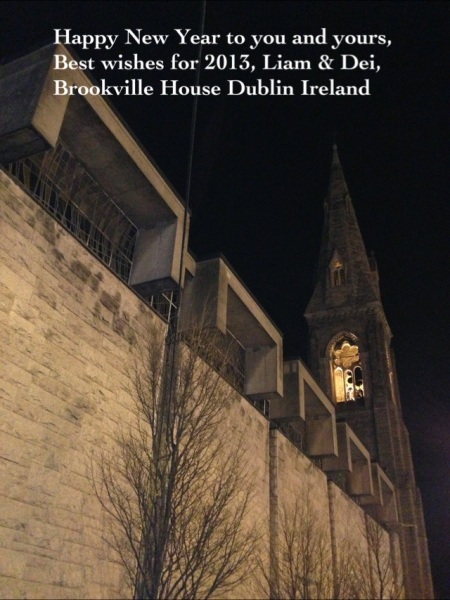
“Happy New Year, Best Wishes for 2013 from Brookville Guest House Dublin Ireland”
As one door closes on the year 2012 and another door opens to usher in 2013 Brookville Guest House Dublin Ireland wishes all our guests, friends, family, followers and fans a bright and Very Happy New Year. Thank you to our guests who stayed with us in 2012 for enriching our lives with happy memories and experiences, thank you for the lovely reviews, the photo memories, cards, emails, letters and gifts from your home countries, we are glad you enjoyed our Irish home from home and we hope you will come back and see us again soon, we look forward to welcoming you. Have a Very Happy, Healthy, Peaceful and Prosperous 2013 everyone and may the New Year bring all that you wish for yourselves.
Our Irish Blessing for the New Year
May the road rise up to meet you,
May the wind always be at your back,
May the sun shine warm upon your face,
And the rains fall soft upon your fields,
And until we meet again, may God
Hold you in the palm of His hand.
May love and laughter light your days,
and warm your heart and home.
May good and faithful friends be yours,
wherever you may roam.
May peace and plenty bless your world
with joy that long endures.
May all life’s passing seasons
bring the best to you and yours!
And May God give you…
For every storm, a rainbow,
For every tear, a smile,
For every care, a promise,
And a blessing in each trial.
For every problem life sends,
A faithful friend to share,
For every sigh, a sweet song,
And an answer for each prayer,
All the Very Best to each and every one of you for the Coming Year.
Gelukkige nuwe jaar
Sana Sa-eeda
Shuvo Nabo Barsho
Soursdey Chhnam Tmei
Feliç Any Nou
Xin Nian Kuai Le 謹 賀 新 年
Sretna Nova godina
Godt Nytår
Gelukkig Nieuwjaar
Kiortame pivdluaritlo
Felican Novan Jaron
Onnellista Uutta Vuotta
Bonne Année
Bliadhna mhath ur
Prosit Neujahr
Kenourios Chronos
Hauoli Makahiki Hou
L’Shannah Tovah
Naye Varsha Ki Shubhkamanyen
Sun Leen Fai Lok
Boldog Ooy Ayvet
Selamat Tahun Baru
Saleh now mobarak
Sanah Jadidah
Bliain nua faoi mhaise dhuit
Felice anno nuovo
Farsælt komandi ár
Akimashite Omedetto Gozaimasu
Saehae Bock Mani ba deu sei yo
Newroz Pirozbe
Laimīgo Jauno Gadu!
Laimingu Naujuju Metu
Is Senat Tajba
Nawa Barsha ko Shuvakamana
Godt Nyttår
Nupela yia i go long yu
Saleh now ra tabrik migouyam
Manigong Bagong Taon
Szczesliwego Nowego Roku
Feliz Ano Novo
Nave sal di mubarak
An Nou Fericit
С Новым Годом (S Novim Godom)
Manuia le Tausaga Fou
Sretna nova godina
A stastlivy Novy Rok
Sreèno novo leto
Iyo Sanad Cusub Oo Fiican
Féliz Año Nuevo
Heri Za Mwaka Mpyaº
Gott nytt år!
Warsa Enggal
Eniya Puthandu Nalvazhthukkal
Sawadee Pee Mai
Yeni Yiliniz Kutlu Olsun
С Новым Годом Z novym rokom
Naya Saal Mubbarak Ho
Chuc Mung Tan Nien
Blwyddyn Newydd Dda

Tags:2013, Aviva stadium, Avoca, b&b, bed and breakfast, Blackrock, Blackrock Clinic, Bord Gais Theatre, Bray, Brookville Guest House, Brookville House Dublin, Cabinteely, car parking, Christmas, concert accommodation, corporate accommodation, Dalkey, Deansgrange, Dublin, Dublin airport, Dublin Port, Dun Laoghaire, family accommodation, Foxrock, free wifi, Garden of Ireland, Glendalough, greetings, guest, guest accommodation, guest house, Guinness, holiday, home, Homecoming, hospitality, hostel, hotel, hydrotherapy, Ireland, Irish, Irish breakfast, Leopardstown, Monkstown, new year, O2, pet friendly, racing, RDS, Riveria, rugby accommodation, sauna, sea, Seasons Greetings, Smurfit, spa, staycation, Stillorgan, student accommodation, The Gathering, tourism, tourist, tradition, travel, Trinity College, UCD, UCD accommodation, vacation, Wicklow
Posted in 2012, 2013, accommodation, bed and breakfast, Brookville House Dublin, customs, Dublin, fans, festival, festive, guest, guest house, heritage, holiday, hospitality, hotel, Ireland, irish, irish blessing, new year, Seasons greetings, Sightseeing, The Gathering, Tours, tradition, travel, Vacations | Leave a Comment »
January 1, 2013


“Happy New Year, Best Wishes for 2013 from Brookville Guest House Dublin Ireland”
As one door closes on the year 2012 and another door opens to usher in 2013 Brookville Guest House Dublin Ireland wishes all our guests, friends, family, followers and fans a bright and Very Happy New Year. Thank you to our guests who stayed with us in 2012 for enriching our lives with happy memories and experiences, thank you for the lovely reviews, the photo memories, cards, emails, letters and gifts from your home countries, we are glad you enjoyed our Irish home from home and we hope you will come back and see us again soon, we look forward to welcoming you. Have a Very Happy, Healthy, Peaceful and Prosperous 2013 everyone and may the New Year bring all that you wish for yourselves.
Our Irish Blessing for the New Year
May the road rise up to meet you,
May the wind always be at your back,
May the sun shine warm upon your face,
And the rains fall soft upon your fields,
And until we meet again, may God
Hold you in the palm of His hand.
May love and laughter light your days,
and warm your heart and home.
May good and faithful friends be yours,
wherever you may roam.
May peace and plenty bless your world
with joy that long endures.
May all life’s passing seasons
bring the best to you and yours!
And May God give you…
For every storm, a rainbow,
For every tear, a smile,
For every care, a promise,
And a blessing in each trial.
For every problem life sends,
A faithful friend to share,
For every sigh, a sweet song,
And an answer for each prayer,
All the Very Best to each and every one of you for the Coming Year.
Gelukkige nuwe jaar
Sana Sa-eeda
Shuvo Nabo Barsho
Soursdey Chhnam Tmei
Feliç Any Nou
Xin Nian Kuai Le 謹 賀 新 年
Sretna Nova godina
Godt Nytår
Gelukkig Nieuwjaar
Kiortame pivdluaritlo
Felican Novan Jaron
Onnellista Uutta Vuotta
Bonne Année
Bliadhna mhath ur
Prosit Neujahr
Kenourios Chronos
Hauoli Makahiki Hou
L’Shannah Tovah
Naye Varsha Ki Shubhkamanyen
Sun Leen Fai Lok
Boldog Ooy Ayvet
Selamat Tahun Baru
Saleh now mobarak
Sanah Jadidah
Bliain nua faoi mhaise dhuit
Felice anno nuovo
Farsælt komandi ár
Akimashite Omedetto Gozaimasu
Saehae Bock Mani ba deu sei yo
Newroz Pirozbe
Laimīgo Jauno Gadu!
Laimingu Naujuju Metu
Is Senat Tajba
Nawa Barsha ko Shuvakamana
Godt Nyttår
Nupela yia i go long yu
Saleh now ra tabrik migouyam
Manigong Bagong Taon
Szczesliwego Nowego Roku
Feliz Ano Novo
Nave sal di mubarak
An Nou Fericit
С Новым Годом (S Novim Godom)
Manuia le Tausaga Fou
Sretna nova godina
A stastlivy Novy Rok
Sreèno novo leto
Iyo Sanad Cusub Oo Fiican
Féliz Año Nuevo
Heri Za Mwaka Mpyaº
Gott nytt år!
Warsa Enggal
Eniya Puthandu Nalvazhthukkal
Sawadee Pee Mai
Yeni Yiliniz Kutlu Olsun
С Новым Годом Z novym rokom
Naya Saal Mubbarak Ho
Chuc Mung Tan Nien
Blwyddyn Newydd Dda

Tags:2013, Aviva stadium, Avoca, b&b, bed and breakfast, Blackrock, Blackrock Clinic, Bord Gais Theatre, Bray, Brookville Guest House, Brookville House Dublin, Cabinteely, car parking, Christmas, concert accommodation, corporate accommodation, Dalkey, Deansgrange, Dublin, Dublin airport, Dublin Port, Dun Laoghaire, family accommodation, Foxrock, free wifi, Garden of Ireland, Glendalough, greetings, guest, guest accommodation, guest house, Guinness, holiday, home, Homecoming, hospitality, hostel, hotel, hydrotherapy, Ireland, Irish, Irish breakfast, Leopardstown, Monkstown, new year, O2, pet friendly, racing, RDS, Riveria, rugby accommodation, sauna, sea, Seasons Greetings, Smurfit, spa, staycation, Stillorgan, student accommodation, The Gathering, tourism, tourist, tradition, travel, Trinity College, UCD, UCD accommodation, vacation, Wicklow
Posted in 2012, 2013, accommodation, bed and breakfast, Brookville House Dublin, customs, Dublin, fans, festival, festive, guest, guest house, heritage, holiday, hospitality, hotel, Ireland, irish, irish blessing, new year, Seasons greetings, Sightseeing, The Gathering, Tours, tradition, travel, Vacations | Leave a Comment »
December 26, 2012

Brookville House Dublin Ireland wishes you and yours a Very Happy St. Stephen’s Day (Lá Fhéile Stiofáin), also known here as The Day of the Wren (Lá an Dreoilín), it is an occasion to commemorate the life of St Stephen, a Christian martyr. To our friends in the United Kingdom we wish you and yours a Happy Boxing Day. Today is a big day for racing especially at Leopardstown Racecourse (less than 2km from Brookville House) and hunting in Ireland and traditionally the post Christmas sales start in the shops. In some parts of Ireland, children go from door to door with a wren (a small bird) in a cage or a model wren on a stick as legend links episodes in the life of Jesus to the wren. They sing, play music or perform traditional dances. In some areas, boys may dress as girls or women. Many hope to collect money for community or school projects or charity. Depending on which region of the country, they are called wrenboys and mummers. A Mummer’s Festival is held at this time every year in the village of New Inn, County Galway and Dingle in County Kerry. Actually, the famous Irish writer John B. Keane based his novel ‘The Bodhran Maker’ on the activities of the Wren Boys in his native County Kerry.
Locally The Wrens Boy Festival takes place each year in Sandymount. This year The Wren Boys celebration at Sandymount Green, Dublin 4 commences at 11.00am with poetry readings in Gus Ryans Pub. The music and dancing kicks off at 12am on the Gig Rig, with the Swords Mummers, the Ned O’Shea Musicians/Dancers, the Shamrockers and many others from far and wide playing bodhrans, bagpipes, tin whistles and even combs along with musicians across all cultures to add variety and excitement to the day. Proceeds go to charity.
St. Stephen’s Day is also a popular day in Ireland for visiting family members. A popular rhyme, known to many Irish children and sung at each house visited by the wrenboys goes as follows (this version popularized by the Irish group The Clancy Brothers):
The wren, the wren, the king of all birds,
St. Stephen’s Day was caught in the furze,
Although he was little his honour was great,
Jump up me lads and give us a treat.
As I was going to Killenaule,
I met a wren upon the wall.
Up with me wattle and knocked him down,
And brought him in to Carrick Town.
Drooolin, Droolin, where’s your nest?
Tis in the bush that I love best
In the tree, the holly tree,
Where all the boys do follow me.
Up with the kettle and down with the pan,
And give us a penny to bury the wren.
I followed the wren three miles or more,
Three miles or more three miles or more.
I followed the wren three miles or more,
At six o’clock in the morning.
I have a little box under me arm,
Under me arm under me arm.
I have a little box under me arm,
A penny or tuppence would do it no harm.
Mrs. Clancy’s a very good woman,
a very good woman, a very good woman,
Mrs. Clancy’s a very good woman,
She give us a penny to bury the wren.
A variant sung in the County Cork had a different explanation why the wren was the King of birds:
The wren, the wren, the King of All Birds,
On Saint Stephen’s Day he was caught in the furze.
Although he is small his family is great.
Come out, good lady, and give us a treat.
St Stephen is believed to be the first Christian martyr. He was stoned to death sometime around the year 33 CE. According to an Irish legend, he was betrayed by a wren while hiding from his enemies. Another legend tells of Viking raids on Ireland on St Stephen’s Day sometime around the year 750 CE. Irish soldiers were approaching a Viking camp to drive out the intruders. However, a wren started eating crumbs from a drum and alerted the Vikings to the presence of the Irish soldiers.
Hence, some people felt that wrens betrayed them and should be stoned to death, just as St Stephen was. Boys traditionally hunted a wren and threw stones at it. They tied it to a stick when it was dead and paraded it around the village. They did this to collect money for a dance or party for the whole village. Although the custom of killing wrens on December 26 died out around 1900, St Stephen’s Day is still known as the Day of the Wren, particularly in rural areas.
St Stephen’s Day has been a holiday in Ireland for hundreds of years. It became a public holiday following the Bank Holidays Act 1871.

Tags:accommodation, Boxing Day, Brookville House, custom, dance, Dingle, Dublin, festival, folklore, horse, hunt, Ireland, Irish, Kerry, legend, Leopardstown, music, racing, sales, Sandymount, st Stephens Day, tradition, wren
Posted in bed and breakfast, birds, boxing day, Brookville House Dublin, Christmas, customs, Dublin, festival, festive, guest, guest house, Happy Christmas, heritage, holiday, hotel, hunt, Ireland, irish, irish blessing, Merry Christmas, mummers, Seasons greetings, st stephens Day, Tours, tradition, travel, twitter, wren | Leave a Comment »
December 25, 2012
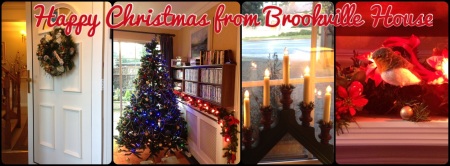


Nollaig Shona daoibh go leir! Happy Christmas! Joyeux Noël, Frohe Weihnachten, Buon Natale, Feliz Navidad, Wesołych Świąt, Geseënde Kersfees, Gëzuar Krishtlindjet, عيد ميلاد سعيد, Шчаслівага Раства, Честита Коледа, Bon Nadal, 圣诞快乐, 聖誕快樂, Sretan Božić, Veselé Vánoce, Glædelig jul, Hyvää joulua, Bo Nadal, Καλά Χριστούγεννα, Nwèl kè kontan, חג מולד שמח, हैप्पी क्रिसमस, Boldog Karácsonyt, Selamat Natal, ハッピークリスマス, 메리 크리스마스, Честит Божиќ, Selamat Natal, Milied it-Tajjeb, God Jul.
Happy Christmas to our family, friends, fans, followers, to all who we welcomed here for the first time this year and to those who stayed with us over the years- you arrived as guests and left as friends with a special place in our hearts, we thank you for wonderful times shared, laughter and special memories, for sharing your lives, countries and cultures with us, we hope you enjoyed your time here in your Irish home from home, thank you for your support, we look forward to welcoming you back in 2013, we wish a wonderful festive season to one and all, all our love, thanks and warmest wishes always, enjoy and look after each other, mile buiochas agus dea ghui, nollaig shona dhaoibh go leir, Liam and Dei, Brookville House
Enjoy the following festive photos taken in the locality during the 2012 festive season.
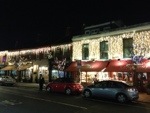


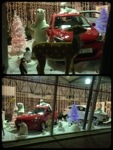

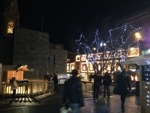

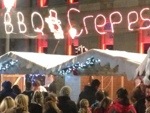

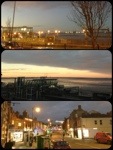


Tags:bed and breakfast, Christmas, December, festive, guest, holiday, hospitality, hotel, house, Ireland, Irish, Santa, Seasons Greetings, travel, vacation
Posted in bed and breakfast, Brookville House Dublin, Christmas, Christmas tree, Dublin, fans, festive, guest, guest house, Happy Christmas, holiday, hotel, Ireland, Merry Christmas, Seasons greetings, Sightseeing, snow, travel, Vacations | Leave a Comment »
January 1, 2012
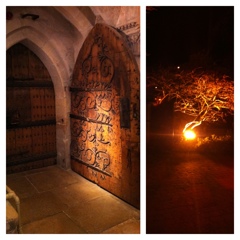
“Happy New Year, Best Wishes for 2012 from Brookville Guest House Dublin Ireland”
As one door closes on the year 2012 and another door opens to usher in 2012 Brookville Guest House Dublin Ireland wishes all our guests, friends, family, followers and fans a Very Happy New Year. Thank you to our guests who stayed with us in 2011 for enriching our lives with happy memories and experiences, thank you for the lovely reviews, the photo memories, cards, emails, letters and gifts from your home countries, we are glad you enjoyed our Irish home from home and we hope you will come back and see us again soon, we look forward to welcoming you. Have a Very Happy, Healthy, Peaceful and Prosperous 2012 everyone and may the New Year bring all that you wish for yourselves.
Our Irish Blessing for the New Year
May the road rise up to meet you,
May the wind always be at your back,
May the sun shine warm upon your face,
And the rains fall soft upon your fields,
And until we meet again, may God
Hold you in the palm of His hand.
May love and laughter light your days,
and warm your heart and home.
May good and faithful friends be yours,
wherever you may roam.
May peace and plenty bless your world
with joy that long endures.
May all life’s passing seasons
bring the best to you and yours!
And May God give you…
For every storm, a rainbow,
For every tear, a smile,
For every care, a promise,
And a blessing in each trial.
For every problem life sends,
A faithful friend to share,
For every sigh, a sweet song,
And an answer for each prayer,
All the Very Best to each and every one of you for the Coming Year.
| Gelukkige nuwe jaar |
| Sana Sa-eeda |
| Shuvo Nabo Barsho |
| Soursdey Chhnam Tmei |
| Feliç Any Nou |
| Xin Nian Kuai Le 謹 賀 新 年 |
| Sretna Nova godina |
| Godt Nytår |
| Gelukkig Nieuwjaar |
| Kiortame pivdluaritlo |
| Felican Novan Jaron |
| Onnellista Uutta Vuotta |
| Bonne Année |
| Bliadhna mhath ur |
| Prosit Neujahr |
| Kenourios Chronos |
| Hauoli Makahiki Hou |
| L’Shannah Tovah |
| Naye Varsha Ki Shubhkamanyen |
| Sun Leen Fai Lok |
| Boldog Ooy Ayvet |
| Selamat Tahun Baru |
| Saleh now mobarak |
| Sanah Jadidah |
| Bliain nua faoi mhaise dhuit |
| Felice anno nuovo |
| Farsælt komandi ár |
| Akimashite Omedetto Gozaimasu |
| Saehae Bock Mani ba deu sei yo |
| Newroz Pirozbe |
| Laimīgo Jauno Gadu! |
| Laimingu Naujuju Metu |
| Is Senat Tajba |
| Nawa Barsha ko Shuvakamana |
| Godt Nyttår |
| Nupela yia i go long yu |
| Saleh now ra tabrik migouyam |
| Manigong Bagong Taon |
| Szczesliwego Nowego Roku |
| Feliz Ano Novo |
| Nave sal di mubarak |
| An Nou Fericit |
| С Новым Годом (S Novim Godom) |
| Manuia le Tausaga Fou |
| Sretna nova godina |
| A stastlivy Novy Rok |
| Sreèno novo leto |
| Iyo Sanad Cusub Oo Fiican |
| Féliz Año Nuevo |
| Heri Za Mwaka Mpyaº |
| Gott nytt år! |
| Warsa Enggal |
| Eniya Puthandu Nalvazhthukkal |
| Sawadee Pee Mai |
| Yeni Yiliniz Kutlu Olsun |
| С Новым Годом Z novym rokom |
| Naya Saal Mubbarak Ho |
| Chuc Mung Tan Nien |
| Blwyddyn Newydd Dda |
0.000000
0.000000
Tags:2012, Aviva stadium, b&b, bed and breakfast, Blackrock, Blackrock Clinic, Brookville Guest House, Brookville House Dublin, car parking, concert accommodation, corporate accommodation, Dublin, Dublin airport, Dublin Port, Dun Laoghaire, family accommodation, Foxrock, free wifi, Grand Canal Theatre, greetings, guest accommodation, guest house, Happy New Year, holiday, home, hostel, hotel, hydrotherapy, Ireland, Irish, Irish breakfast, Irish hospitality, Irish welcome, Monkstown, New Year's Eve, O2, pet friendly, RDS, rugby accommodation, sauna, Smurfit, Stillorgan, student accommodation, tourism, travel, UCD accommodation, vacation, Wishes
Posted in bed and breakfast, Brookville House Dublin, Dublin, fans, festive, guest, guest house, holiday, hotel, Ireland, irish blessing, new year, Seasons greetings, Sightseeing, Tours, travel, Uncategorized, Vacations | Leave a Comment »






























